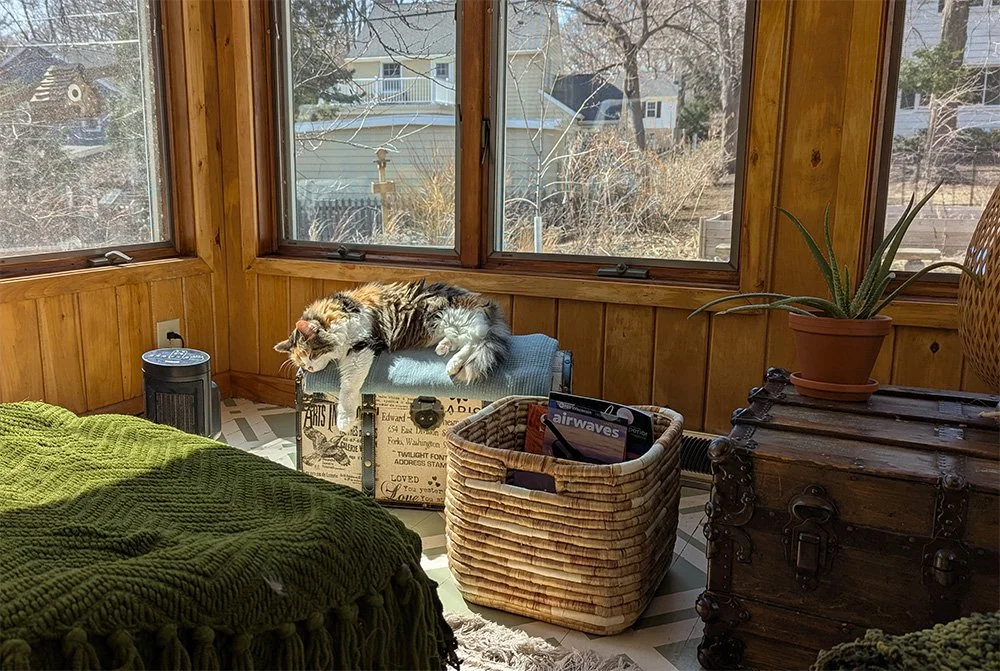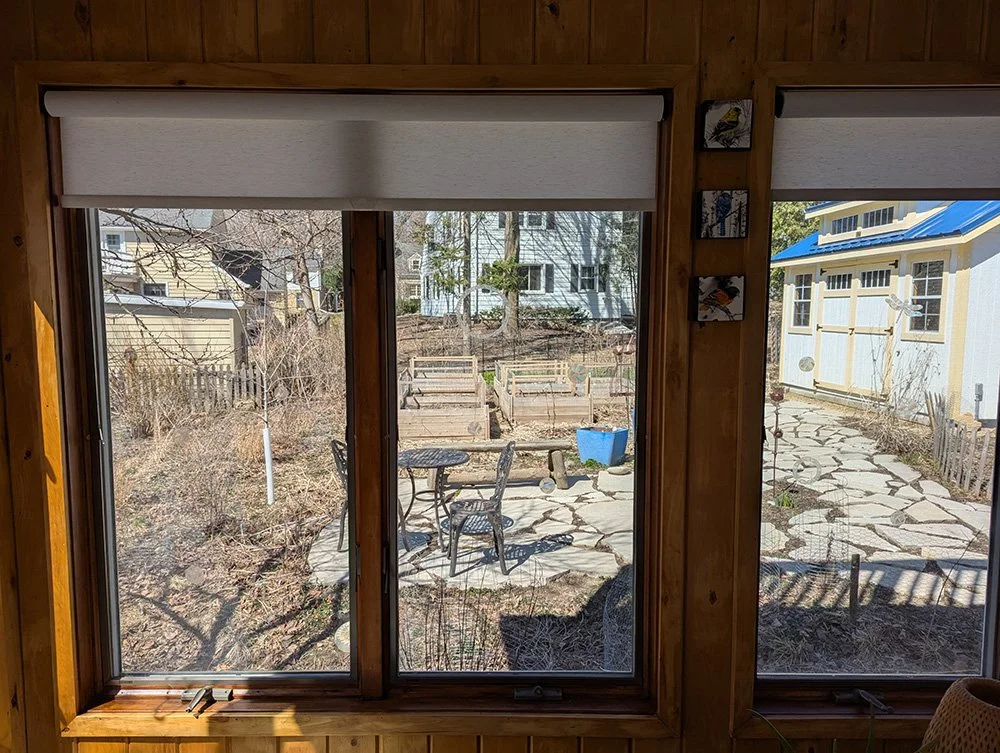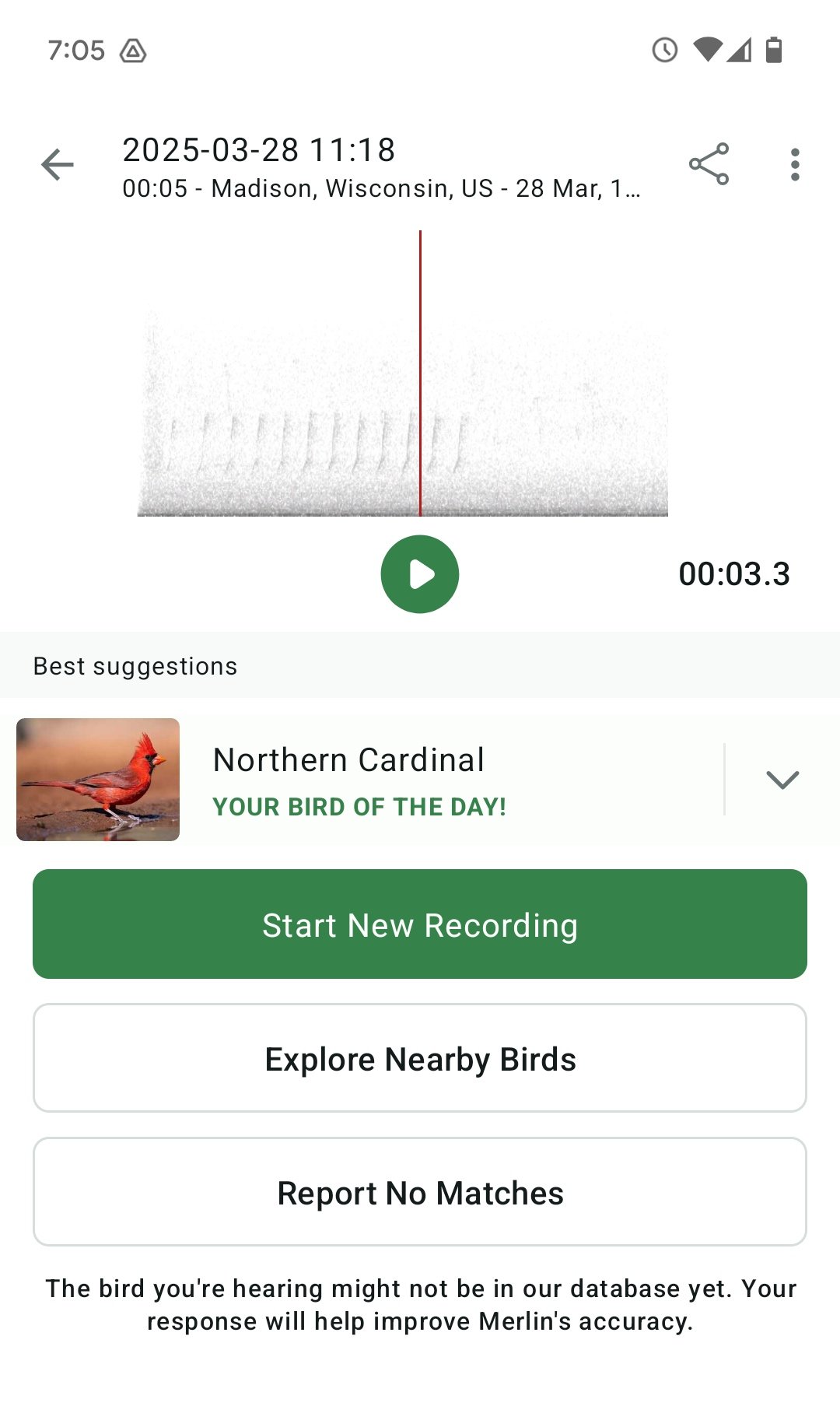The Chippy Times
Chubby-Cheeked Chatterers Herald Spring, Taunt Cat
Thanks to our kitchen remodel, when our amazing friends at Reliable Renovations turned our kitchen door into a window and our dining room windows into double doors to give us more kitchen space, Lucas, Annie, and I have had the pleasure of easily watching each season of our backyard wildlife, commercial-free and with no need to worry about the internet crapping out, which it often does on our actual TV.
Throughout winter, Annie prefers to spend the early morning in our laps, but that changes as soon as the chipmunks emerge. A few minutes of pets and she’s done, off to her seat at the door where, like Gladys Kravitz from Bewitched, her nose is a tenth of an inch from the glass as she spies the goings-on. Lucas has his coffee, I enjoy my oatmeal, and Annie flicks her tail as her reliable morning chipmunk scrabbles up the step, inevitably chewing its own breakfast, sometimes yelling at somebody.
Banner illustration note: I drew this based on the chipmunk photograph by Natureworks on morguefile.
Morning chipmunk news
Annie never notices the mid-afternoon chipmunk, but I do. While the cat naps, sprawled across a footrest, a chipmunk often perches on the patio bench with a snack, occasionally lying down too, maybe for its own quick snooze, or more likely hunkering down to avoid something bigger and meaner catching sight of it. How it’s ever gutsy enough to stand up on the bench, like a little lord of all it surveys, I may never know.
Annie‘s afternoon coma — oblivious to the chipmunk right outside
This spring a chipmunk with a red behind has joined our backyard crew, sparking questions. Will the red fade away as it gets older? Are there other ways we could identify individual chipmunks? Do they get along with the birds or do they exist in such different spheres that the two species might as well never cross paths?
All these questions and the title of this post, of course, are inspired by Amy Tan’s The Backyard Bird Chronicles. This was such a nice book to accompany March, when every robin is a sign that spring is really, truly, surely here. Not only are the entries bite-sized and easy to take a quick break with, but Amy Tan’s illustrations and notes are charming, and her dedication inspiring.
Did you have a favorite entry in the book? Did The Backyard Bird Chronicles inspire you to ask any questions about wildlife or the world around you? Would you consider trying nature journaling?
Human At Last Gets Act Together, Protects Against Bird Strikes
Thanks to Amy Tan’s book, I resolved to finally do something about our sunroom windows, which have sadly been the source of several bird strikes since we moved in. I decided to try ‘window gems’ and planned to wash the windows and put them up on Saturday. If I’d gotten up ten minutes earlier that morning, I could have spared a dark-eyed junco a bad headache at the very least, and saved its life at the most. Though it flew off later, it sat stunned for such a long time I was sure it was dead. Unfortunately, it may not have lasted long after that.
We’ll need more window gems to cover our problem windows and doors, but it seemed wisest to test them out before buying a large batch. According to the instructions the gems may be installed inside, but they work much better if applied outside. As I slapped them on the window, I really wondered if they would hold up to a big storm. I didn’t have long to wait. It stormed hard soon after, and the gems didn’t budge. I like the simple design of circles and rings, but they also offer many animal and plant shapes.
Find window gems on Etsy or windowgems.com
Sunroom with window gems applied — pretty unobtrusive!
I’m happy to do this one small thing for the birds, so minor in the face of the thousands of mealworms Amy Tan provides her feathered friends. I laughed out loud when she tried to get the neighbor kid to raise the wriggly little things. I fully support that kid’s mother vetoing the idea—Lucas tried to raise crickets once for our bearded dragon Beryl (may she rest in peace) and I was decidedly not a fan.
Did you know that bugs are an important source of food for most birds and their babies? This is yet another reason why it’s important to avoid pesticides, to plant native plants (part of the insect life cycle and habitat) and to wait to do any yard cleanup until May. Let’s give the birds their best shot, especially considering those devastating baby bird survival stats Tan shares.
Are you taking any steps to make your house or yard more bird- or wildlife-friendly this year?
Lucas tossed fennel and broccoli scraps outside for the rabbits. This was seconds before a fight. The rabbit on the right succeeded in driving off the rabbit on the left.
Opinion: Birds Deliver Joy and Wonder
If you read The Backyard Bird Chronicles and thought, ‘This is not enough, give me more!’ — I’m happy to provide.
Science Friday: The Factors That Make Bird Sounds So Diverse Across the World
(approx. 15 min podcast segment)
Listen on the SciFri website >>
Listen on Spotify >>
Amy Tan on Facebook — more drawings and even drawing tips!
Download the free Merlin app by the Cornell Lab of Ornithology and start identifying the birds around you by the sounds they make! So far I’ve recorded: Sandhill Crane, Common Goldeneye, Common Grackle, European Starling, Black-capped Chickadee, Rock Pigeon, Ring-billed Gull, and a Northern Cardinal. It’s fun to watch the spectrogram as the sound is recorded. I found the giant spike when Lucas sneezed from two rooms away pretty amusing.
If you have Netflix and haven’t watched the documentary Dancing with the Birds, set aside an hour to enjoy this audio-visual treasure narrated by Stephen Fry. Then another hour the next time someone comes to your house so you can enjoy watching it all over again with them. Watch the trailer >>
Want some guidance nature journaling? Amy Tan learned from John Muir Laws’s classes, but he has books available too. I personally have The Laws Guide to Nature Drawing and Journaling (Goodreads). The ways it encourages you to think and explore are handy for more than just nature journaling. Also available is The Laws Guide to Drawing Birds (Goodreads).
I used The Laws Guide to Nature Drawing and Journaling when I worked on the chipmunk in the banner above. Though I was using pencils in Procreate, the tips were still helpful. I initially sketched on paper in blue pencil. My first version looked like a weasel! My second looked like a rat. I finally thought this version was chippy enough. When it came to the colors, I still felt a bit unsure on how to get the appropriate richness. In Procreate I have a bit of a secret weapon, which was duplicating what I had a couple of times until it was as dark as I liked. I know that’s not always going to turn out so well, so I’ll tuck back into the book and keep working on getting the proper saturation the first time around.
30 second time-lapse video of the drawing process
And finally, a book I desperately wish I’d put on our list for this year: Birding to Change the World by Trish O’Kane. A fair chunk of this memoir is about her life in Madison, so that makes it extra special to me, but you don’t have to be familiar with Madison for this book to resonate. I’m about halfway through, and this book fills me with hope and motivation. Plus the illustrations are a delight. Goodreads | Barnes & Noble | Bookshop.org
Cabbage and eggplant seeds officially started!
April’s Book
The Milkweed Lands: An Epic Story of One Plant by Eric Lee-Mäder and illustrated by Beverly Duncan is a beautifully illustrated book that allows us to follow along with milkweed for a year. The book is just over 100 pages.
I will also keep digging into The Laws Guide to Nature Drawing and Journaling. I hope you’ll consider joining me in some nature journaling, with or without the book!
April Challenge: Spend a few minutes observing a bird, insect, or other creature outside.
What do you know about it?
What don’t you know about it?
What would you like to know?
What do you think might be true about it?









